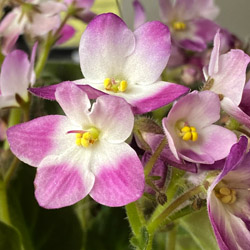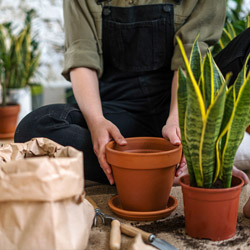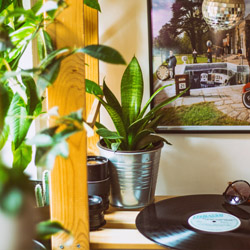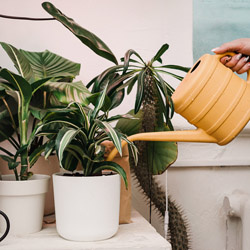No matter what the size or style of your own personal urban habitat, you can add stunning nature with the right houseplants. Furthermore, when you grow your own urban jungle, you can realize and enjoy all the benefits houseplants bring to your home.
Benefits of Urban Houseplants
Houseplants bring a range of benefits into any home with every leaf and bloom. Not only do plants improve oxygen levels by drawing carbon dioxide from the air, they also remove other pollutants and odors, particularly in smaller urban homes where airborne toxins may be more concentrated. Houseplants also lower dust levels and improve humidity indoors, which can help alleviate allergies, respiratory conditions, dry skin, and other health problems. Larger houseplants help dampen unwanted sounds, creating a more tranquil atmosphere. Studies have also shown that houseplants improve mood and relaxation by providing a tangible connection to nature, which can help reduce depression and Seasonal Affective Disorder. With so many benefits, adding even one or two houseplants to your home can help create more positive, enjoyable surroundings, and a full urban jungle can become your sanctuary in the city.
Best Plants for an Urban Home
There are many types of houseplants to choose from, any of which will bring numerous benefits to your home. Before choosing, however, consider the levels of sunlight in your home, as well as changing light levels throughout the year, to be sure you can provide adequate light for a particular plant to flourish. Overall room temperatures can also affect plants, as some thrive in cooler climates while others prefer warmer rooms. Note the available space you have and choose a plant that won’t soon become crowded or cramped, which can inhibit growth. Also be aware of the ongoing care each plant will need and whether your schedule will permit you to maintain the plant well, or if you need a plant that is a bit more forgiving of neglect.
The top houseplants that thrive in urban households include:
- African violets
- Cacti
- Cast iron plant
- Dracaena species
- Dumb cane
- Ferns
- Golden pothos
- Lucky bamboo
- Peace lily
- Snake plants
- Spider plants
- Succulents
Depending on the size of your home and how green your thumb is, you may choose to start with just one or two houseplants, or you could opt for an entire jungle. Ideally, one medium-sized houseplant is best for every 100 square feet of living space to keep the air clean, but you can have as many or as few plants as you wish for your happiness.
Caring for an Urban Jungle
It is easy to keep houseplants lush, but they do need dedicated care to stay healthy.
- Choose a Proper Pot – The pot should be the right size for your houseplant. A too-small pot will cramp the plant and inhibit growth, while a too-large pot will encourage overgrowth and legginess on different plants. The pot should also have suitable drainage to keep the root system healthy and avoid rot.
- Use Good Quality Soil – Rather than outdoor soil that may not be as rich and could bring pests into your home, opt for a good quality potting mix formulated for houseplants. These mixes will often have moisture-retention beads or fertilizer pre-mixed into the soil, making houseplant care easier. You can also look for specialty blends for cacti, succulents, flowering plants, and other specific types of houseplants.
- Water Appropriately – Overwatering or underwatering can be deadly for houseplants. Check your plant’s specific watering needs and adjust watering as needed for different seasons. Choosing self-watering pots or using globe watering stakes can also help keep a houseplant safely watered.
- Feed Regularly – Houseplants need occasional fertilizer applications to supplement the nutrition they draw from their potting soil. Choose a liquid fertilizer formulated for your specific plants and follow application instructions on the product label. Most houseplants’ nutritional needs are reduced during the winter months.
- Provide Sufficient Light – Different houseplants have different sunlight needs. Some will do very well in shadier spots, while others need filtered light or even a few hours of bright sunlight. Moving plants to different locations in different seasons can help them get adequate light and rotating the pots will help plants grow straight without stretching to reach the sun.
- Position Safely – Place houseplants away from hazardous situations such as areas where they may be accidentally tripped or tipped over. Avoid creating your urban jungle near heating or cooling vents and cold winter drafts. Keep houseplants out of reach of pets that may nibble on leaves or dig in pots.
- Prune as Needed – Keep your urban jungle looking tidy by pruning and trimming plants to maintain their shapes or remove dead leaves. Brown tips can also be trimmed for a neater appearance but avoid vigorous pruning that could stress the plant.
- Watch for Pests – Fungus gnats, mealybugs, spider mites, and other pests can invade even the most well-protected urban jungle. Stay alert for any pests and take steps immediately if they do appear. Plant-friendly insecticidal soaps, top dressing treatments, neem oil, and other control options are available depending on which pests are present.
- Clean Your Plants – Refresh houseplants and brighten your urban jungle with regular cleanings. Dust, dirt, and other debris can gather on plants’ foliage, clogging respiratory pores and dulling the plants’ color. A quick rinse in the shower or regular dusting with a moistened cloth and a gentle hand can keep plants looking their best.
Your urban jungle can bring you many benefits, whether you just have one or two houseplants, a simple plant collection, or an elaborate nature sanctuary in your home. By choosing the best plants for urban living and providing them with proper care, they will in turn nurture you and help you reconnect with nature, no matter where you live.










